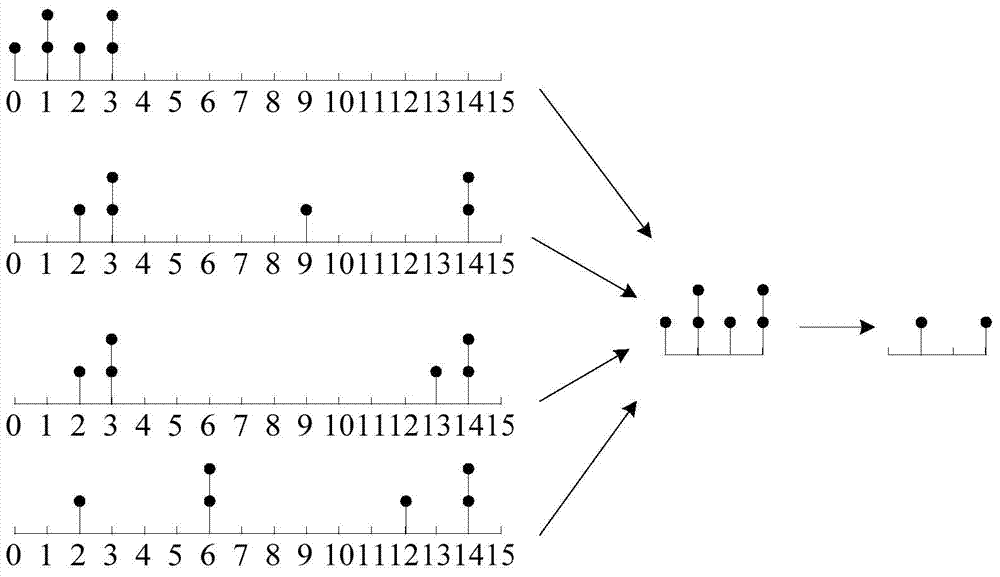Pulse encoding and decoding method and pulse coder-decoder
A technology of pulse coding and pulse, which is applied in the direction of instruments and voice analysis, etc., can solve the problems of waste of coding bits, accumulation of coding index redundancy, large computational complexity, etc., and achieve the effect of saving coding bits
- Summary
- Abstract
- Description
- Claims
- Application Information
AI Technical Summary
Problems solved by technology
Method used
Image
Examples
Embodiment 1
[0064] Embodiment 1. A pulse coding method, such as figure 1 Shown, including:
[0065] A1. Obtain pulses to be encoded on T tracks, where T is an integer greater than or equal to 2.
[0066] The total number of pulses that need to be encoded on each of the T tracks is usually determined according to the code rate. The more pulses that need to be encoded, the more bits are needed for the encoding index, and the higher the code rate. In this article, use pulse_num t Represents the total number of pulses to be encoded on the t-th track, assuming tε[0, T-1]; The total number of pulses on each track of joint coding can be the same or different.
[0067] A2. Count the pulses to be encoded on each track according to their positions, and obtain the number N of pulse positions on each track t , The distribution of pulse positions on the track and the number of pulses in each pulse position.
[0068] In this article:
[0069] Take pos_num t Represents the number of pulse positions on the t-th t...
Embodiment 2
[0123] Embodiment 2. A pulse coding method. In this embodiment, each track of joint coding is calculated separately and then combined into a coding index, such as image 3 Shown, including steps:
[0124] B1. Obtain pulses to be encoded on T tracks, where T is an integer greater than or equal to 2.
[0125] B2. Count the pulses to be encoded on each track according to their positions, and obtain the number N of pulse positions on each track. t , The distribution of pulse positions on the track and the number of pulses in each pulse position.
[0126] Steps B1 and B2 can be performed with reference to steps A1 and A2 in the first embodiment.
[0127] B3. Determine the first index I1 of each track according to the number of pulse positions on each track. t , The first index I1 t Corresponding to the number of pulse positions it represents, there are all possible distributions of pulse positions on the track.
[0128] B4. Determine the second index I2 of each track according to the distrib...
Embodiment 3
[0138] The third embodiment is a pulse coding method. This embodiment is based on the first or second embodiment and proposes a method for further saving coded bits.
[0139] The coding index Ind generation process of the pulse coding method of this embodiment can be performed with reference to the method in Embodiment 1 or 2, and the following operations are performed after the coding index Ind is generated, such as Figure 4 Shown, including:
[0140] C1. Compare the coding index Ind with the adjustment threshold THR, where,
[0141] THR≤2 Bmax -I max (T),
[0142] I max (T) represents the upper limit of Ind, and Bmax represents the upper limit of the number of bits used to encode the coding index. If Ind is less than THR, go to step C2, otherwise go to step C3.
[0143] C2. Use the first number of coded bits to code Ind.
[0144] C3. Use the second number of coded bit pairs plus the offset value THR 0 Ind for encoding, THR≤THR 0 ≤2 Bmax -I max (T), the said first quantity is le...
PUM
 Login to View More
Login to View More Abstract
Description
Claims
Application Information
 Login to View More
Login to View More - R&D
- Intellectual Property
- Life Sciences
- Materials
- Tech Scout
- Unparalleled Data Quality
- Higher Quality Content
- 60% Fewer Hallucinations
Browse by: Latest US Patents, China's latest patents, Technical Efficacy Thesaurus, Application Domain, Technology Topic, Popular Technical Reports.
© 2025 PatSnap. All rights reserved.Legal|Privacy policy|Modern Slavery Act Transparency Statement|Sitemap|About US| Contact US: help@patsnap.com



